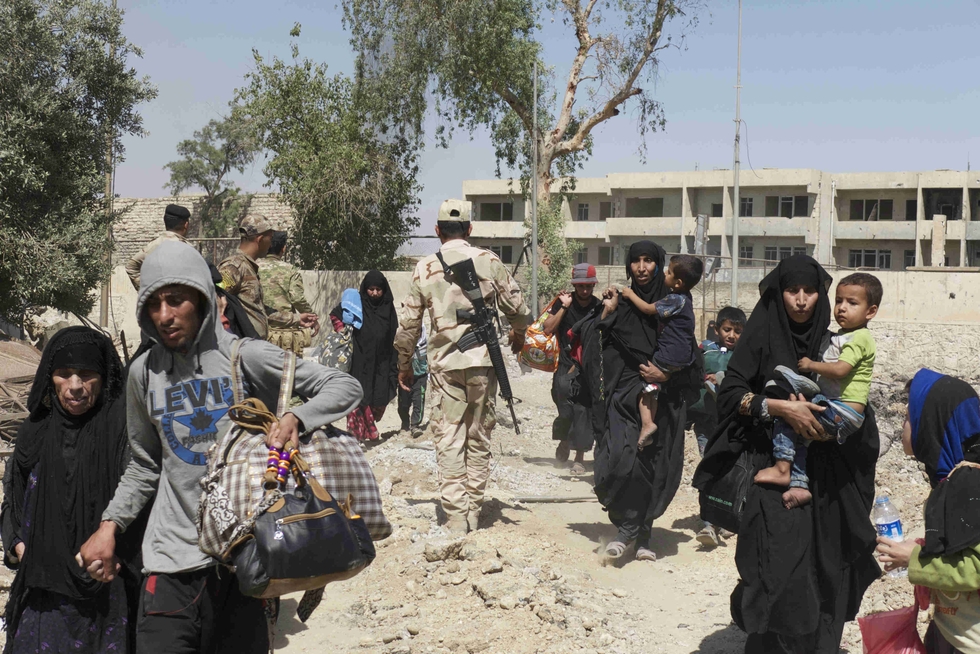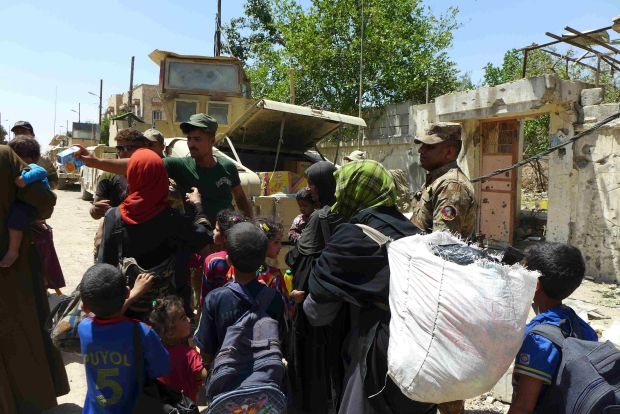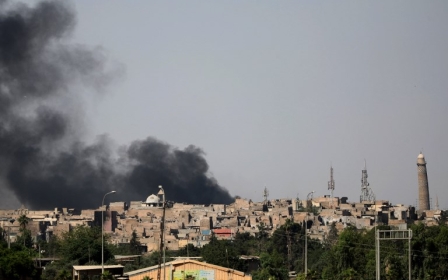Hell on earth: Mosul civilians flee as IS makes last stand

MOSUL, Iraq - A straggling group of civilians appears at the edge of the rubble-strewn frontline in Mosul during a lull in the fighting.
A soldier shouts to them to stay where they are - the last road they must cross to reach Iraqi army positions is overlooked by an Islamic State (IS) sniper. Air strikes that have been pounding IS positions all morning have failed to eliminate this mobile and active sniper.
Unhearing or unheeding, the civilians press on, straight into the sights of the shooter.
Several soldiers rush forward to grab young children and carry them to safety, urging the others to run. But wounded, traumatised and weakened by months of malnutrition, most of the civilians can only stumble forward.
'Where is my family? Where is my family? Where are they?'
- Saad, eight years old
“Everything in there, around the university, is destroyed, utterly destroyed,” gasps 64-year-old former judge Mohammed, gesturing towards the Al-Shifa district behind him, one of the last pockets outside Mosul Old City where fighting still rages.
On Thursday, IS destroyed the symbolic Grand al-Nuri Mosque from which IS leader Abu Bakr al-Baghdadi declared his "caliphate" in 2014, as Iraq's elite Counter Terrorism Service inched within 50 metres of it.
Gratefully downing a bottle of water, Mohammed pulls out his government ID card, showing his name and former profession as proof.
He explains how he spent three years living in terror of his identity as a former judge being discovered by IS, who systematically executed soldiers, police and former government employees in Mosul during their three-year reign of terror.
“They killed my friend - a policeman - by putting him in a cage with two others and drowning him,” he says, the words catching in his throat as he remembers the horror.
Lost children
“Where is my family? Where is my family?” cries eight-year-old Saad, who has a colourful woman’s handbag in his arms and two dead chickens at his feet.
A soldier washes his tear-streaked face with bottled water, but the boy refuses to eat or drink, desperately scanning the faces of the group.
“Where are they?” he pleads, tears streaming down his face.
The soldier kisses him on the forehead, reassuring him that they will be found, words of comfort if not than truth.
In the chaos of flight, many become separated and, running the gauntlet of incoming mortars, air strikes and snipers, they did not all make it out.
While civilians gratefully consume water and biscuits, soldiers identify an IS suspect after discovering tell-tale bruising around his armpit after looking under his shirt.
Bruises caused by the kickback from repeatedly firing a gun are one of the ways the military manning this frontline - several miles from the nearest civilian screening point - can identify IS suspects.
But the suspect insists the bruising was sustained from rubble flying after a mortar strike.
Looking sceptical, soldiers ask civilians if any recognise him.
Mohammed, the former judge, confirms that the man was not with IS and he is allowed to follow the trailing line of women and children.
They start walking slowly through streets reduced to rubble by the fighting and lined with the blackened, decomposing corpses of IS fighters and overturned cars.
The next group of civilians follows a different route that the army has opened up, where a broken wall offers some protection from the sniper.
They shout that there are wounded who cannot walk and several soldiers and a volunteer French medic dash across the road.
Civilian casualties
Another air strike hits nearby and the body of a girl flies high into the air.
“She was wearing a red dress. She was thrown 50 metres into the sky above me. I saw her so clearly,” says a Swedish photographer who witnessed the event, sweat pouring down his face after dashing back across the road.
'She was wearing a red dress. She was thrown 50 metres into the sky above me. I saw her so clearly'
- Swedish photojournalist
“I could see her red dress. She was just a girl,” he repeats, desperately.
The French medic - Aude - returns, after patching up an elderly couple with shrapnel injuries and helping soldiers move the corpse of another young woman from the frontline into a nearby abandoned school.
The dead woman - beautiful and in her 20s - was decked in gold jewellery, valuable possessions with which she had hoped to escape. The body will only be taken to a cemetery when armoured vehicles are able to reach the position.
More and more civilians are appearing, carting their humble possessions in rice sacks that have been fashioned into makeshift rucksacks. A man carries a disabled relative on his back. Another hobbles forward on crutches.
Most are women and children, their blank faces and wide eyes no longer registering fear, even as the bombs are still falling just a few hundred metres away.
“Most of the young men still inside now are with Daesh - we’re 100 percent sure they are Daesh - so very few are coming out,” says Iraqi Army officer Jabbar, 51, referring to IS by their Arabic acronym. Three arrests have already been made that morning.
Many of the civilians are wounded, pieces of shrapnel still lodged in their arms and legs. A boy screams as a medic cleans a wound on his calf with iodine. Some have professionally dressed wounds, their broken limbs locked into place with medical rods forming external frames.
Screening for IS
“Of course these operations were done by IS medics and we know they only look after their own, so these men were probably with IS,” says Aude.
“But it’s difficult for soldiers to prove anything here on the frontline and the soldiers know these men will face two proper screenings before they leave Mosul.”
'IS clinics are so well-stocked, with literally thousands of dollars' worth of modern equipment and medicines'
- Aude, French medic
Checking on open wounds and injuries roughly dressed by family or friends in grubby bandages or strips of fabric, she says frontline medics have taken advantage of well-stocked IS field hospitals found in newly liberated areas.
“It’s crazy. IS clinics are so well-stocked, with literally thousands of dollars worth of modern equipment and medicines,” she says, adding that most medicines have 2016 production dates.
“I was injured 12 days ago by a mortar,” says Najam, 61, gesturing towards his roughly bandaged and now unmoving right hand. “Someone in the basement where we were hiding helped me tie it up with a splint.”
He and his wife are from Baghdad, but have been trapped in Mosul for two and a half years after coming here to rescue their daughter.
“After Daesh came to Mosul, my daughter’s husband was always in trouble. He refused to grow a beard or give up smoking, and kept being arrested and punished. [He was] beaten badly, numerous times,” says Najam.
“One day he phoned us, saying he planned to try and run away to Turkey and we should come and get our daughter.”
He was aware of the dangers of entering the IS-held city, but some movement in and out of Mosul was still possible in those early days, and Najam thought that being a family unit from Baghdad would give them some leeway.
They entered Mosul without difficulty but, when they tried to leave with their daughter, they were denied permission to exit.
“We tried many times to leave. Each time, I explained that my house was in Baghdad and we just wanted to go home, but each time they said it was forbidden and sent us back. Sometimes I was punished, sometimes I was not.”
His voice breaking, he mutters: “We had to come to save our daughter, but it has been almost three years since I saw my home. Three terrible years.”
Another man in his 60s, a former lecturer at Mosul University, pauses to look a Western journalist in the eyes and says in careful English: “Tony Blair is the problem. But now the game is over,” before trudging on.
As the trickle of civilians peters out, two soldiers come back from frontline positions where a planned advance of several hundred Iraqi army soldiers stalled the previous night under heavy fire from IS.
The face and hand of one are heavily bandaged but he is more interested in proudly showing the spoils he seized from a dead IS fighter, an AKS-74U - a Kalashnikov-variant termed the ‘Osama’ by Iraqi soldiers because it was Osama bin Laden’s weapon of choice - and three loaded clips of ammo.
The soldiers say their unit, which has been stuck in three buildings for almost 24 hours, needs food and water.
As fighting again intensifies, no more civilians emerge, but today more than 600 have escaped from this part of the city. It is a good day by west Mosul standards, one when IS fighters began pulling back, enabling hundreds to take their chances to try and escape amid air strikes and mortars.
The next day, the battered stretch of road - still overlooked by a sniper who has somehow evaded numerous air strikes in the last 24 hours - remains empty, traversed only intermittently by soldiers and the occasional military vehicle.
This article is available in French on Middle East Eye French edition.
Middle East Eye propose une couverture et une analyse indépendantes et incomparables du Moyen-Orient, de l’Afrique du Nord et d’autres régions du monde. Pour en savoir plus sur la reprise de ce contenu et les frais qui s’appliquent, veuillez remplir ce formulaire [en anglais]. Pour en savoir plus sur MEE, cliquez ici [en anglais].








